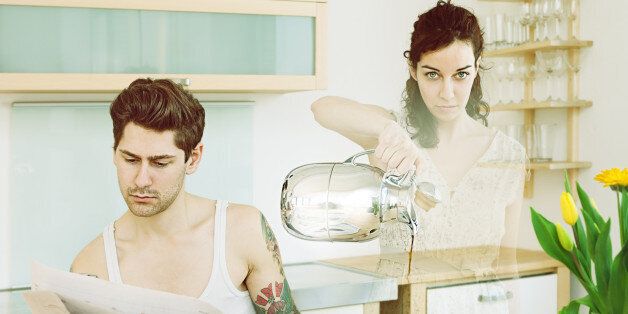
Every Sunday my wife and I used to fight. It became a bit of a ritual actually, as soon as the Sunday Times landed with a reassuring thud onto the kitchen table we scrabbled over the sections. And then one day I made a dreadful error. 'A sexist pig' was what my wife called me, and she was right. Today, I wonder what she'd make of the people who actually run the paper.
Anyway, she grabbed the main news section as I plunged the coffee. 'But I want to read that,' I said, 'why can't you have a look at Style magazine.' You see, men are meant to read the news while women are meant to look at pretty pictures of clothes and handbags. Even metrosexuals like me succumb to the casual sexism lurking in our genes.
Needless to say, she put me right and I now read whatever section she allows me to. After I've made the coffee.
Today, however, I suddenly saw the newspaper in a new light. On the contents section of my tablet edition, there was a plug for this week's roster of six comment writers: all of them white and middle-aged and only one of them a woman.
I then went through the entire News, Business and Culture sections looking at all the columnists - the ones with picture bylines, unrelated to the reporting of the day's news. I counted 21. And only one of them was a woman - Sarah Baxter, the gifted Deputy Editor of the paper. That's 21 columnists writing about politics, society, economics, business, gossip, radio, the arts, television and their own caustic opinions. And all of them bar one were men. There were of course a number of other female writers - I was just concentrating on the columnists.
So what, you might say. Good writing is good writing regardless of gender. And yes that is true. Except one can't help wondering why all the brilliant female writers working on the Sunday Times are in the Style and Magazine sections (which are both edited by women). Is that where they're 'meant' to be?
The media is never slow to point out the iniquity of male domination in other industries but I wonder if there is a problem closer to home.
Of 11 daily newspapers, two (the Guardian and Star) are edited by women. Of the nine Sundays, only the Sun and Sunday People have female editors. That makes a fifth of national newspapers edited by women. Of the three weekly current affairs magazines - The Spectator, New Statesman and Economist - only the last is edited by a woman. And yet the readership is nearly always split down the middle. Indeed, according to the Sunday Times's own figures, almost 47% of its readers are women, mostly aged over 35.
It shouldn't really matter who edits as long as there's a good mix in the team. And the Sunday Times certainly has that - not just Baxter but Eleanor Mills too, who is its editorial director. Eleanor (who I've finally forgiven for the job rejection 12 years ago) is also one of the most outspoken critics of the male domination of British newspapers and is Chair of the campaigning Women in Journalism group.
She co-wrote an enormously interesting paper recently on how women are portrayed through a male-dominated lens that controls the news agenda and particularly its front pages. In it, she rightly castigates the Daily Mail's infamous 'Legs-it' splash-headline, which celebrated the lower limbs of the Prime Minister and her Scottish counterpart during what was a significant and serious moment in the Brexit debate.
And that's why this week's edition of the Sunday Times fascinates me. The paper's editor, Martin Ivens, boasts some of the strongest voices and best writers in British media, many of them women, and yet he can find room for only one of them - outside of the magazines - to write a column about the news, business or culture.
The newspaper is not alone. Some time ago I wrote about the astonishing bias exhibited by the Financial Times in its choice of interviewees for the prestigious Lunch With... slot on Saturday. I went back through 100 slots and found just 18 women had been interviewed. After I published the piece on LinkedIn in February, I was inundated with emails and tweets from FT staffers and freelancers bemoaning the male-dominated culture in the newsroom. I know it is entirely unrelated, but since my piece appeared, the gender ratio has been 50-50.
I don't think editors are (on the whole) 'sexist pigs' but there is no doubt that women's voices - despite the incredibly talented array of female writers - are badly unrepresented. Perhaps it is a blindspot exhibited by men. Or maybe it's a legacy issue, that despite the efforts of Eleanor and others the outdated culture is simply too entrenched.
However, I think there is another far more disturbing reason for the preservation of this macho status quo. Put simply, journalists like me aren't meant to write stuff like this, to turn on our own (especially editors) and point out supposed faults. We've got our careers, contacts and friendships to think about. And when you're not in a position of power - ie me, not Eleanor - don't bite the hand that feeds you.
I'm fortunate. I run a consultancy providing media advice and written material for a wide range of businesses and individuals, which means I don't have to rely on journalism to pay the bills. Plus, I'm able to bypass the newsroom decision-makers and self-publish. The Mail and Guardian aside, newspapers and editors don't traditionally slag off other newspapers and editors, so there aren't many homes for pieces like this.
But, as we're seeing in Hollywood at the moment, unless we are honest with ourselves and debate this equality issue openly, we'll never solve a problem that we pretend isn't even there.
